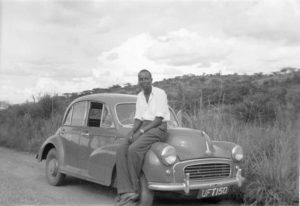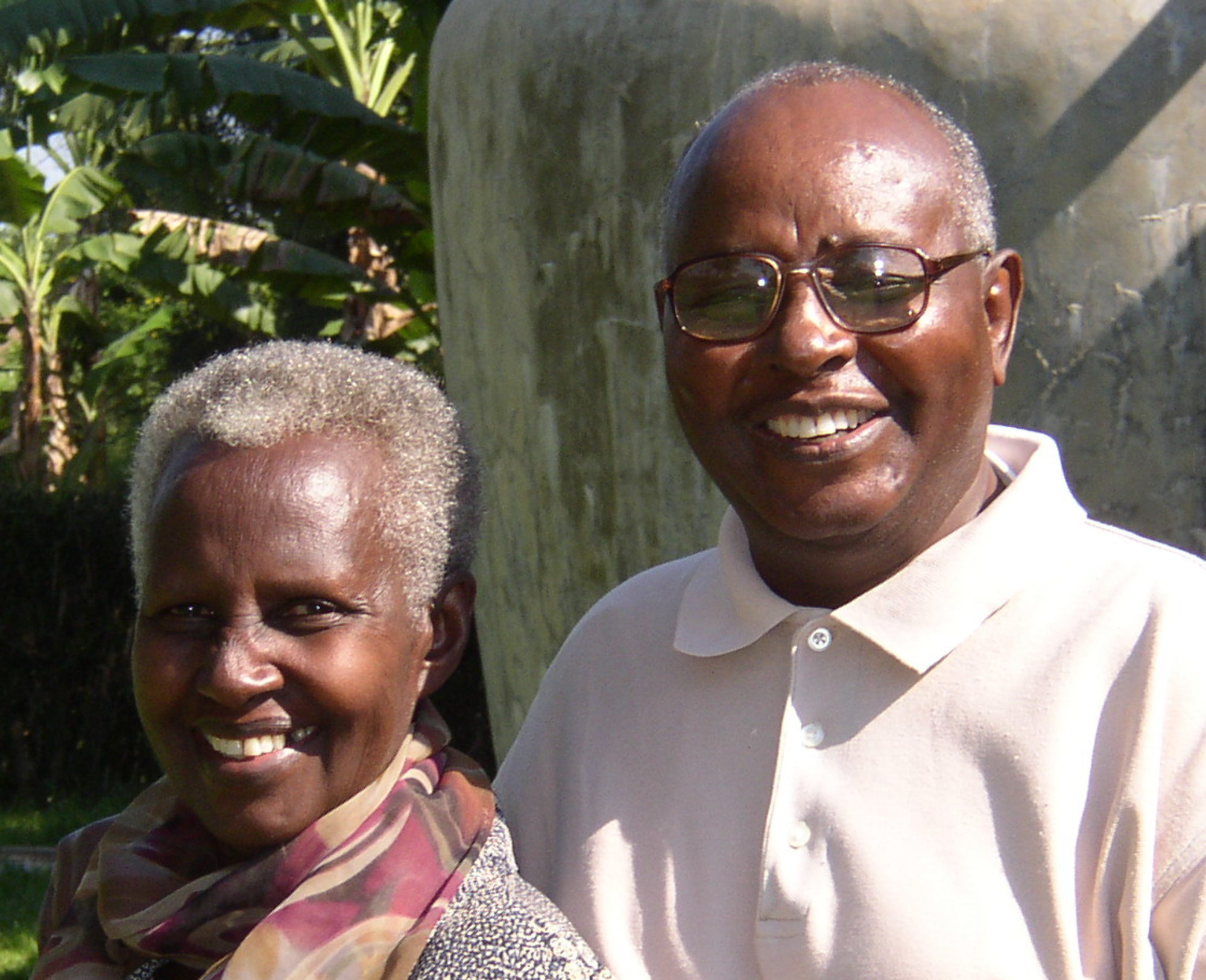It was during his final year in Mbagathi that Godfrey responded to God’s call on his life. A missionary named Mr. Johnston, whose ministry was to reach out to the students at the training institution approached Godfrey and shared with him the words of salvation using the words of Revelation 3:20 “Behold I stand at the door and knock, if any man hear my voice and open the doorI will come into him and sup with him and he with me.” After a discussion with Mr Johnston he struggled internally that afternoon and went to the soccer field alone and prayed to accept God’s call. Following that talk Godfrey accepted Christ as his personal Lord and Savior on April 1st 1951. He felt a burden fall off his back and went back into the dormitory to let his friends know. Their response to him was to ask for his cigarettes. He hesitated then gave them that pack in his pocket and retained one cigarette. He lit it up that cigarette and it did not taste the same as always and that was the last cigarette he ever smoked. An answer to his aunt Mariamu’s prayer and vision. Another note to make is that at the time of his conversion experience his sister Esther Nyenshaija who was back in Ankole later told Godfrey that she had had a vision of this event and knew that he had accepted Christ as his personal Savior and Lord.
He immediately got connected with the brethren in the Nairobi fellowship of the East African Revival and was filled with excitement at his new found faith. Godfrey’s life made a complete turn around. He completed his course at Mbagathi that year and returned to Uganda to start work. He was embraced by the East African Revival (balokole) movement in Uganda.
The East African Revival movement that started around 1929 in Kampala was in its second decade during the early fifties when Godfrey was in Mbagathi. The revival movement had been started by the movement of the Holy Spirit amongst the souls of yearning men. A regular meeting of young men who worked in the local government including a humble British missionary medical doctor, Dr. Joe Church, Blasio Kigozi and his brother Simeoni Nsibambi. These young men in their twenties would meet in the Synod hall at Namirembe Cathedral for prayer and this resulted in the movement of the Holy Spirit in the entire East African region. Dr Church was posted to Gahini, Rwanda another Anglican mission station and the work continued with other young men like Yosia Kinuka. The movement grew exponentially with such evangelical fervor. Peoples lives were changed and the very culture of this region was changed. The balokole challenged the status quo. Not only did their faith become vibrant but tribal norms were challenged, from names to totems to eating habits. They travelled across the region and the unifying movement was identified by the revival song “Tukutendereza Yesu“. This song could be heard in Mombasa-Kenya, Arusha-Tanzania, Goma-Congo, Lira-Uganda at gatherings of the faithful. This was indeed an indigenous spiritual revival and is still going till this day.
Godfrey’s first posting was in Masaka, where he was taken in by the fellowship in town. The Lukwago, Baddu and Bugembe families embraced him. They taught him in his young years the walk of humility and faith. He then returned to Mbagathi for some further training and it was a very different experience as he was used to lead fellow students to the Lord and enjoyed fellowship with the brethren in Nairobi. It was during this time that he felt a deep conviction to return home to witness this great message to his own elderly father.
Upon his return to Kampala, Godfrey shared this conviction with the elders who urged him to calm down and let God’s will take control. However he was very sure that God had told him his father would come to know Jesus. He travelled to Ntungamo where his father was. When he arrived he sat down and let his father know what had happened to him and urged him to consider Christ. His father immediately recognized the message and right there and then prayed for Christ to come into his life. Godfrey described the prayer as a conversation between the old man and God and at the end of it he repeated ‘Amen’ three times. Godfrey was excited and happy to see this happen. His father then proceeded to remove all the equipment and items he used for his soothsaying and fortune telling from his house and started a bonfire to destroy them all. Later Godfrey reached out to his mother Pharesi and her mother Elizabeth and they all accepted Christ too. After many years of separation his father and mother were reconciled. His father got baptized and took the name of Simeon. Just like Simeon in the New Testament he had finally seen the Lord in his old age.
Godfrey got posted to Kabale and yet again fellowshipped with brethren there too. The testimony of these elders shaped Godfrey’s life for years to come. After Kabale he was posted back to Kampala and decided not to take the housing provided by his job at East African Post & Telecommunications (EAP&T). Instead he opted to live with Christian families as a child in their homes and receive the nurturing he needed to grow spiritually. He began in Kabowa with the Lugemwa family. He then moved to Nansana where he stayed with Mukulu Samalie in the home of the Lukwago family. The Lukwago’s were still in Masaka where Yosia Lukwago was still working with the EAP&T.
At this time Godfrey owned a bike and rode to work in the Telephone House in downtown Kampala every day. After a few years he was excelling at his work as a telephone technician and this was recognized by his superiors. They chose to promote him to the Asian grade and this came with a lump sum payment of arrears amounting to about 13,000 Uganda shillings. He told the elders in the fellowship and they were pleased for him. When asked what his plans were for so much money he let them know of his dream to buy a motorbike. The brethren then advised him against this and instead asked him to buy a car since it could be used to further the spiritual work of Christ in the area. He had learned well and humbled himself to their guidance. He then recalls the story of how they chose the car he would buy. A few of the brethren including Rev. Matovu and Mr. Nyonyitono, went to the auto store and looked at different cars. There was a discussion as to what size the car should be and Taata Matovu thought a big car would be good since it could take more brethren as they travelled to their different mission trips. However Taata Nyonyintono prevailed and reminded them that Godfrey was a young man and his earnings would not be able to handle the petrol bills and maintenance. Godfrey’s first car was a Morris Minor.

Not only did the brethren buy the car but they taught him how to drive it. After work he would bike to the place where he was to receive his driving lessons and the car was brought by Taata Nyonyintono. He would complete his lesson, get back on his bike and make his way home to Nansana. He finally got his drivers license and started driving the car. Mukulu Samalie then noticed a change in Godfrey. He would come home in the car after a long day at work and park it at home. Mukulu Samalie would then remind him that he had to go the well and bring back a tin can (ddebe) of water. The well was inaccessible by car. His attitude to this daily chore changed after he got his car … and she made it a point to let him know it. ” .. owoluganda Godfrey kilabikka nti emotokka eno egyakutuletela ekizibu” (brother Godfrey it looks like this car is going to bring us some problems). He would then get the ddebe and head off for the well. The car surely accomplished the work of the Lord too with or without Godfrey. Somedays he would park his car at work and the brethren would pass by his workplace to pick up the keys and drive off to some outreach mission. A great lesson in fellowship, community and humility.
Godfrey was known around Kampala as a young man of vibrant energy for spreading the gospel to all and sundry. He was single and free to expend his energy with mission trips and fellowship matters. He had a deep respect for the elders especially Taata Nyonyintono and Taata Mondo. He spent a lot of time with Yona Mondo. As time went by the brethren were interested in finding a mate for Godfrey although he seemed to be just fine as a single man. A few ideas of young ladies were brought forward and he found one reason or another to not move forward with these suggestions. It was after a mission outreach to Bweranyangi Secondary School by a team of brethren that included Reverands Festo Kivengere and Peter Kigozi that a young teacher by the name of Jane Kentembwe made a commitment to salvation that things changed. Peter Kigozi and Festo Kivengere immediately thought that she would make a good match for Godfrey. They came back to Kampala and let Godfrey know their thoughts. He recognized her name from teaching her in Sunday school so many years ago in Mbarara. Godfrey knew she was from a good family and was also well educated. He then agreed to follow through with the courtship . He made his intentions known and Jane and her family accepted his request for her hand in marriage. Jane’s oldest brother was a magistrate in the local courts in Ankole, George Nathan Patrick Kirindi. A well educated man with an obsession for all things Shakespeare. He struck up a good friendship with Godfrey that lasted for their whole lives. Godfrey took Jane to meet his father who at the time was nearing 100 years of age and she was warmly received too. Godfrey and Jane got married on May 6, 1961 in St James Cathedral, Ruharo, Mbarara.
